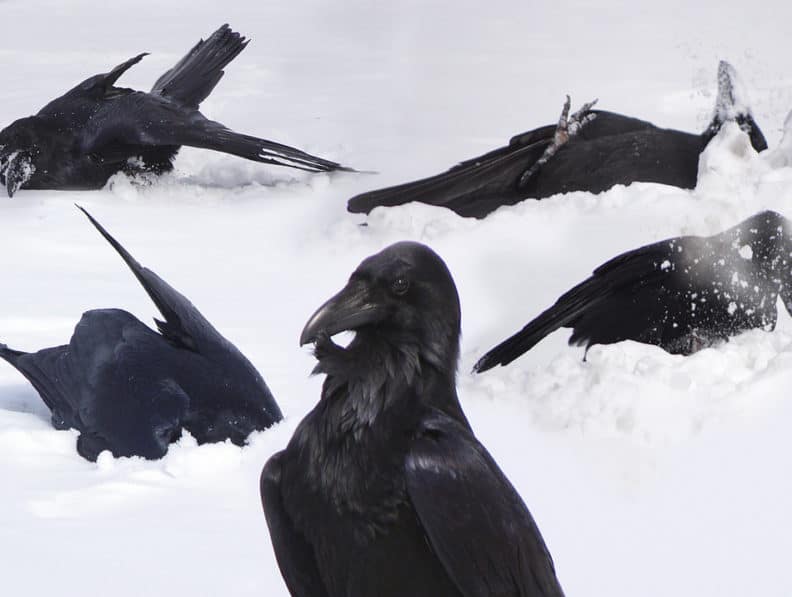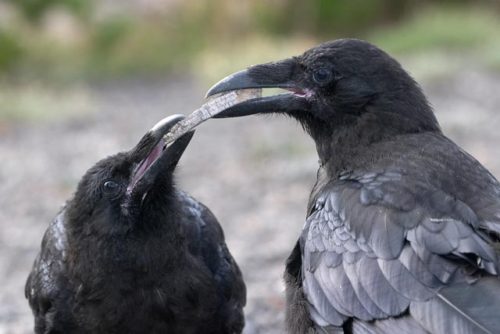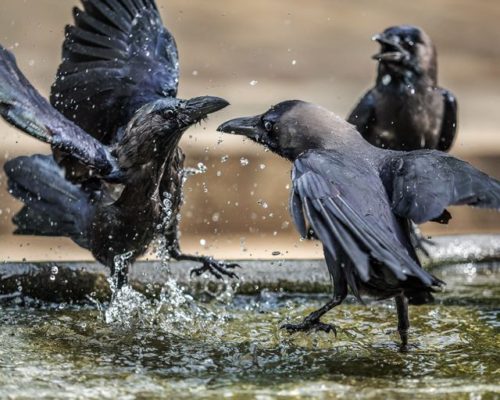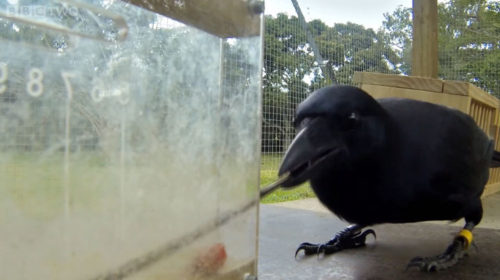
Animal Natural Learning Tendencies: Through the Eyes of a Raven Part II
By Jenny O’Toole, graduate student in the Institute’s 16th cohort. Read Part I – The Birth of Curiosity: Through the Eyes of a Raven here.
Like human babies, ravens are highly curious of all objects upon first leaving the nest. Fearless, they get into everything that’s in front of them and, accompanied by parents who help steer them away from true danger, they are free to explore and learn. As an integral part of exploration, play is a big part of ravens’ lives. Though admittedly difficult to define, Heinrich states that according to most definitions of nonhuman play, it is a behavior that “seems purposeless but possibly just because the observer hasn’t figured out what the benefit is.” Ravens play to have fun, not deliberately to educate themselves. Education is the side effect for which the strong drive to play came about. They play with a full range of skills that are crucial to their long-term survival and wellbeing, which Heinrich talks about in multiple chapters of his book:

Raven tug-of-war. Photo courtesy of North Carolina Museum of Natural Sciences
Through physical play ravens develop strong bodies and graceful movement, such as: hanging upside-down, digging in the dirt, playing tug-of-war, chasing each other, snow-bathing and sliding. Much of this physical play also involves some danger, referred to as “risky play.”
Through risky play ravens learn to manage fear and develop courage, such as pulling other animals’ tails and approaching carcasses that might be equally as appealing to stronger, more threatening animals. In risky play animals also must develop effective communication. Amotz Zahavi, an Israeli biologist, describes effective communication in what he calls the “handicap principle.” Animals must learn first to have reliable signals between the communicators. In order for the receiver to know they’re reliable, they must be costly to make–attracting predators, for example. Heinrich relates two anecdotes of ravens effectively “warning” people of predators lurking, attracting attention to themselves, but also potentially providing themselves a meal if said predator attacks and kills! Through risky play, ravens have even learned to trick animals out of their food—one raven will distract the other animal, for example, and the other will steal its food.
Through play with language, ravens become competent communicators. Heinrich states that ravens learn quickly to be so expressive that with a combination of voice, patterns of feather erection and body posture, ravens communicate anger, affection, hunger, curiosity, playfulness, fright, boldness and (rarely) depression. Through field experiments, he also proved that ravens who are knowledgeable about food can recruit others from communal roosts and can indicate functions such as “feed me,” “stay away,” “come here” and recognition. Ravens are also known to be excellent communicators over generations, due to phenomenal long-term memory. In crow (another member of the corvid family) experiments done by John M. Marzluff, it was discovered that they could quickly and accurately learn to recognize the face of a dangerous person and pass this knowledge on to future generations for at least 2.7 years!
Through play with logic, ravens become logical, perhaps even in relationships they create. According to Heinrich’s studies, wolves and ravens seem to have a symbiotic relationship, the ravens serving as acute eyes and ears, locating the food for the wolf to then kill and share in the consumption. He also mentions ravens creating the same logical relationship with hunters, following the hunter to his kill and eating whatever is left behind. Closely related to logic, Heinrich also tested his ravens for insight, which I will explore later in the section on planfulness.
Through play with tools, ravens become skilled at using those tools. Heinrich regularly mentions ravens, as well as other corvids regularly hammering and/or dislodging objects near them as a displacement behavior when they are angry or frustrated. Heinrch told a story of how two adult ravens repeatedly flew at him when he was climbing in a crevasse, calling loudly, landing on the cliff above, and loosening rocks and sand. Ravens even make toys—a rare animal behavior—by using sticks, pinecones, golf balls, or rocks to play with each other or by themselves.
Through playing socially with others, ravens learn to negotiate, compromise, and get along with their peers, which I will elaborate on in the next section on sociability.
The drive to play serves educative purposes complementary to those of curiosity. While curiosity motivates young ravens to seek new knowledge and understanding, playfulness motivates them to practice new skills and use those skills creatively, developing intelligence.

Ravens bathing. Photo by Patricia Leonard
Sociability
Ravens come into the world with an instinctive understanding that their survival and wellbeing depend on their ability to connect with and learn from other people. Jorg Massen and his colleagues of the University of Vienna found raven sociability to rival that of other mammals, such as primates, that have previously been the only nonhuman animals found to rival human sociability. They found ravens formed and maintained affiliate social relations aside from reproduction and engaged in primate-like social strategies like support during conflicts, and reconciliation and consolation after conflicts.
Animals everywhere learn more by watching and listening to those around them than through any other means. Heinrich mentions sociability in ravens, adding his observation that “possible utilitarian functions are strictly secondary,” when discussing an example of ravens bathing, noting that they never bathe for cleanliness. He describes ravens bathing as a “party activity,” occurring regardless of when or if dirt is removed, the most important factor instead being whether another raven is bathing and they can join in the fun. In all animals, socializing reduces aggression; to be familiar with the others while feeding is to be tolerated. In fact, ravens can recognize friends and foes and Heinrich suggests that the relationships within and between pairs and with other ravens could suggest that these birds evaluate and make choices.

Raven solving a puzzle. Photo courtesy of BBC
Planfulness
Heinrich tested his ravens for insight (or planfulness): the evaluation of different choices to make an intelligent decision without overtly trying them. Any behavior is a combination of innate programming, of blind or unconscious responses, learning and insight. For example, a human’s sexual preferences are innate but determining what kind of flowers to give our mate takes insight modified by learning. Heinrich states, “Insight requires consciousness, but it’s more. It’s the mental visualization of alternative choices that then guide judgment of new situations at the moment.” His experiments with ravens showed they possessed insight, which excluded both observational learning and trial-and-error learning. After pulling up meat from a string, the ravens did not fly off, realizing that the meat was still connected to the string. When multiple strings were presented and new types and colors of strings added, the reaction of the ravens was to go for the new string, not the familiar one previously known to have meat on it, also representing evaluation of choice.
Evolutionary biologist Peter Gray and other cognitive scientists, refers to this capacity to make plans and carry them out as planfulness. Research by such scientists has shown that human children who have ample free time to play and explore on their own and with other children, independent of adults, also develop this capacity more fully than do children who spend more time in adult-structured activities. That is not surprising. When children create their own activities, without adult control, they are continuously practicing the ability to make plans and carry them out. They make mistakes, but they learn from those mistakes.
Each of these four natural learning tendencies I’ve expanded upon through the lens of raven learning, are present at birth within humans as well. A more self-directed education strives to nurture those four learning tendencies toward what I agree with Peter Gray, to be the goal of education: to enable one to live a satisfying and meaningful life. It starts with curiosity which, found through boredom, will be nurtured in all of my future educative endeavors along with playfulness, sociability and planfulness.
Title photo by Stephen

